
Search engine optimization (SEO) was not in existence until the early 1990s but really picked up in the mid-90s. It is at this time that webmasters realized that to rank better on search engines, they had to pay attention to the kind of content that they were churning out.
Download the free Ebook "SEO: The Past, Present, and Future"
1993, was a crucial year in the development of search engines which would later give rise to SEO. The creation of Architext (later known as Excite) in February 1993 changed the cataloging of information making it easier to find information based on back-end optimization and the presence of keywords within the content. In October of the same year, ALIWEB came to be which enabled users to submit their own pages. World Wide Web Worm, JumpStation, and RBSE were introduced to the public in December 1993, which all had the capability to crawl both site content and servers to produce results.
By 1995, alphabetical optimization was taking place with the likes of Yahoo. 1996 saw SEO evolve into using keyword density and seasoning as database algorithms improved. By the time Google was introduced in 1997, search engines had become mainstream. Finding information was easier but it wasn’t always the information one was specifically looking for. As such, the more keywords added into their content, the better ranking that page received. Spammy backlinks and black hat SEO practices were the order of the day by 1999 until the developers of Google launched PageRank, which not only used keywords for page rankings but also introduced a new and improved element of quality. Their algorithm focused less on being advertising-centric and slowly introduced guidelines to the SEO world.
By 2001, PageRank had eliminated spam tactics in site ranking. Google’s bots crawled the internet looking for relevant backlinks and keyword density, completely changing the SEO landscape. With time, Google began to use backlinks more often but soon had to change as people caught on and came up with ways to easily get backlinks, altering site rankings once again.
2005 was a big year for SEO when Google, Yahoo, and MSN came together for the Nofollow Attribute which reduced spammy links and number of comments on websites. In June of the same year, Google introduced personalized search which ranked sites according to one’s browsing history. Google Analytics was introduced in November 2005 and, to this day, is used to measure traffic and campaign ROI.
In 2009, Bing entered the search engine space introducing priority given to the words in URLs and favoring capitalized words as well as those from content on large sites. In August of the same year, Google introduced their Caffeine algorithm change which increased the search engine’s speed and real-time research. By this time, social media sites had also created a niche for themselves in SEO as anyone could then optimize their content for search engines. In 2010, Google Instant technology hit the scene giving users suggestions of what you may be looking for as they type a search query.
Google’s Panda algorithm was introduced in 2011 which cracked down on low-quality content developed to drive traffic to a site. Introduction of the Penguin algorithm in 2012 further cracked down on low-quality sites and rewarded those with high-quality content with a higher ranking. In 2014, Pigeon was released which improved local search results and in 2015 Google went ahead to reward mobile-friendly sites with higher rankings. This changed the landscape of SEO since keywords and content were no longer the only crucial ranking criteria. By 2016, Google had cracked down on mobile pop-ups.
The SEO landscape is ever changing. Moving into the future, SEO will continue focusing on the mobile device experience since desktop usage is reducing gradually. Additionally, we expect to see more development in the voice search area since this is increasing daily. We also suspect that SEO will go local ensuring that you get what is most relevant to the user in their area. Social media indexing is also gaining ground. We are now waiting to see how SEO will play into wearable gadgets. It will be interesting to see the way forward.
Here is a free ebook on us for more SEO tricks and tips.
resources: http://searchengineland.com/evolution-seo-trends-25-years-223424, https://blog.hubspot.com/marketing/a-brief-history-of-search-seo, https://rankexecutives.com/history-seo/, http://www.greenlightdigital.com/blog/posts/the-history-and-evolution-of-seo/, https://en.wikipedia.org/wiki/Search_engine_optimization, https://innovationsimple.com/seo/the-history-of-seo/, http://iml.jou.ufl.edu/projects/fall09/goldkamp_t/history.html


